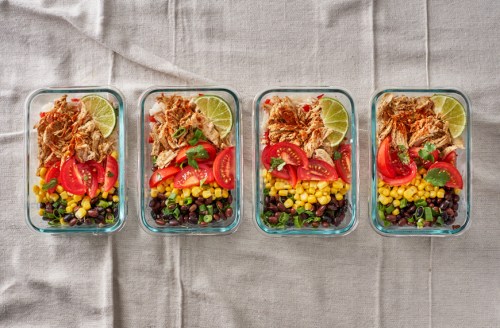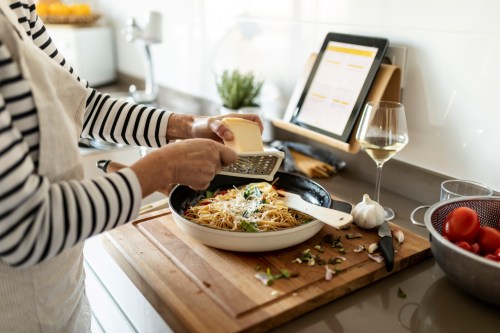Our editors independently select these products. Making a purchase through our links may earn Well+Good a commission
How to meal prep for the week in just 90 minutes (mic drop)
Looking for help on how to meal prep? Check out this comprehensive guide featuring a sample shopping list and recipes to get you started.

The mason jars are pulled out, Spotify is blasting, and you’re ready to get down to meal-prepping business. So, er, where do you start?
If you regularly peruse the interwebs for your upcoming meals, you might get the impression that you have to sacrifice your entire Sunday to yield five days’ worth of colorful, delicious lunches you’ll genuinely look forward to biting into. But listen, fam, that’s a meal-prep myth. And, to prove it, we’ve created the ultimate guide for no muss, no fuss make-ahead food that you’ll actually look forward to reheating. Ready?
What is meal prepping, and, um, why should I bother?
In case you’re new to the wonderful world of meal-prepping (welcome, we’ve been waiting for you) the practice involves making a bulk serving of one or more dishes that you can break into portions, store in the fridge, and enjoy throughout the week. (For example, you could make a five-serving casserole and divvy up the slices for Monday, Tuesday, Wednesday, Thursday, and Friday.)
Normally, this is a habit that’s widely adopted for people with office jobs who don’t want to break the bank on Sweetgreen salads or Chipotle five times a week, but even though many folks are WFH right now, the practice is still a time-saving and—research shows—much healthier. In a web-based observational study of nearly 41,000 participants, researchers determined an association between meal-prepping and healthy eating. “Our results highlighted that individuals planning their meals were more likely to have a better dietary quality, including a higher adherence with nutritional guidelines as well as an increased food variety,” wrote the authors of the 2017 study. Which makes sense, right? You have a lot more say in the ingredients when you make a meal yourself then when you call it in.
Making your food in advance also has financial benefits when you’re working from home. If you find yourself ordering delivery or takeout from a local eatery, you may be spending upward of $10 per day on a salad, when you could make a week’s worth of that same salad for less than an Alexander Hamilton.
And last, but certainly not least, having your breakfast, lunch, snacks, or dinner already prepared can take away the decision fatigue many of us feel… you know, 24/7. Instead of spending time and energy each day figuring out WTF you’re going to eat, you can invest a bit of that time on one day each week to ensure that you have easy, grab-and-go options to work with the rest of the time. Sounds like a no-brainer to me.
Ready? Here’s your step-by-step guide for how to meal prep like a pro
Step 1: Ready your supplies
Tupperware parties may be a thing of the past, but you’re going to have your very own festivities every weekend where you store your meals in your chosen glass, plastic, or metal containers.
There are lots of food storage options to choose from now than just the OG Tupperware option, but a lot of it is on backorder due to COVID-19. So if you want to start meal-prepping, stat, you might consider picking up a set of plastic containers to tide you over the next time you’re at the grocery store. If not, you can get a metal set ($17) or a glass set ($28) delivered on Amazon by late May.
As you’re choosing your storage containers, you’ll want to consider a few things:
- How many containers do I need? Depends on how much you’re planning to prep.If you want to meal prep all your breakfasts and lunches for the work week, you’ll need 10 containers (and lids) in addition to any little salad dressing containers you might want.
- How big should my containers be? It’s useful to have containers of all widths and heights on hand, but you might want to take a moment before you press “buy” to consider if smaller containers or larger containers are better for your kind of lunches. (It’s kinda hard to mix a salad in a small container, but if that size is perfect for your morning overnight oats, then by all means stock up.)
- Am I okay with the different components of meal mingling? We’ve all made the mistake of pairing salad with a sandwich—and wound up with soggy balsamic bread (bleh!) as a result. That’s why compartmentalized containers (like these) can be good for people who like “a little bit of this, a little bit of that” at lunchtime.
Step 2: Reflect on what time commitment and meal prep schedule works for you
Are you a one-pot pasta, make-as-few-dishes-as-possible kind of person, or are you the kind of person that spends an hour plus making gourmet meals each night? This is the kind of self-reflection you need to do before diving into recipes and filling up your shopping cart. “My goal is always to get everything done for the entire week in 90 minutes,” says Leanne Miyasa, blogger behind Simple Healthy Delish.
It’s definitely a goal that you can achieve, too, so give yourself a set time to work with, then decide when cooking fits into your schedule the best. Is it Friday night? Sunday morning? Monday after work?
Last, but certainly not least, you’ll need to have a chat with yourself about whether or not your taste buds are on board with eating the same thing five days in a row. If the answer is a resounding, “nope” then you may consider preparing two meals that you can switch between when you find yourself just plain bored of the same old, same old, rotating your proteins day by day, or whipping up two different sauces that will transform the entire dish. Get creative.
Step 3: Choose a recipe (or two) and make a shopping list
Now that you have a Tupperware army, you’re ready to choose the flavors you want to live with for a week, and luckily, there’s a ton of technology to help you do that. If you decide you want no part in making a grocery list, there are several meal prep apps that take that particular nuisance out of your hands.
The 3 best apps for meal prep
- 1.Mealime ($6 per month for the pro version): I use the free version of Mealime myself, and it’s pretty darn great. The app asks you for your dietary restrictions and then lets you pick from a menu of delicious eats (shoutout to the spicy sweet potato and black bean burrito). Then, once you’ve picked your recipe, the app creates a grocery list that you can add or subtract to, checking off items as you add them to your basket.
- 2.PlateJoy ($69 for a 6-month subscription): If you want to invest a little bit more in your new make-ahead meal habit, PlateJoy is your best bet. It tailors recipes just for you using a personalization quiz that asks questions about your nutrition goals and preferred style of eating. Plus, it accounts for the whole family in the plan—so no more negotiating different diets at the dinner table.
- 3.Yummly ($5 per month for the pro version): Yummly is a goldmine for delicious, healthy recipes—and the free version is excellent. You can filter its many recipes according to the cuisines you like and what your eating plan is. Then, once you’ve picked a recipe, Yummly gives you very clear insights into the macros and nutrition facts of the dish so you can plan your food with your body at front of mind.
The best meal-prep recipes for breakfast, lunch, and dinner
Breakfast: It may be up to debate if breakfast really is the most important meal of the day, but if it’s your fave, here are the morning bites that serve up all the nutrients you need to stay full until lunchtime.
- Overnight oats: Like oatmeal but cold, overnight oats have gained a lot of ~hype~ for good reason: They’re a dietitian favorite and, quite frankly, taste like dessert.
- Muffin tin breakfasts: Everyone, you can make a week’s worth of breakfast using just a muffin tin and a bowl. Have one or two each day for breakfast and you’re set
- Fancy hard-boiled eggs: Hard-boiled eggs really can be sexy—and these recipes prove it.
- High-fiber Paleo bread: Gluten-free eaters can spread this satiating bread with almond butter for breakfast magic every single day. A single loaf yields a week’s worth of joy.
- Sweet potatoes: Sweet potato pancakes can be easily frozen, then popped into the toaster when you’re ready to munch on them.
Lunch: Ah, lunch—the reigning meal prep champion. The internet is replete with healthy lunch recipes you can make in bulk, but here are a few of our favorites:
- A dietitian’s “nourish bowl”: This lunch bowl comes together with the help of pantry staples, and it’s so easy to make in bulk.
- Gluten-free pasta with kale: I can’t think of a better way to look forward to your lunch than to make it a pasta dish—and this one, from chef Klancy Miller, truly reminds you of the power of pasta.
- Salsa soup: Take it from me: This soup just tastes better as the week goes on and the flavors percolate.
- DIY salad: If you’re open to a bit more prep work (you know, slicing and dicing more veggies to get the perfect Chop’t-style salad), then this DIY salad formula is for you.
- Sheet pan veggies: Sheet pan veggies may sound “blah,” but Body Love Everyday author and celebrity nutritionist Kelly Leveque is on a mission to change that. These seasoned sheet pan veggies will make you completely rethink how flavorful a head of broccoli can be.
Dinner: Well+Good recently started a series called “Prep School” that’s all about teaching you how to make a week’s worth of dinners with no heavy lifting. Here are some of the best recipes from the series:
- Stuffed bell pepper bowls and Mongolian beef and broccoli rice bowls: If you’re gluten-free, make these two recipes for zero dinner boredom as the week goes on.
- Vegan Japanese bento boxes: Rice, veggies, and wafu dressing compose this delicious and fresh AF dinner menu.
- Cauliflower dinner feast: This meal plan will help you plan out a week’s worth of meals that revolve around everyone’s favorite cruciferous vegetable—and there all mouth-watering.
- Mediterranean meal prep: Pita pizza, vegan meatballs, and Instant Pot pinto beans are just some of the dinners you’ll be enjoying with this menu.
- Jackfruit carnitas and walnut ground meat: This recipe duo makes five days of Mexican-inspired cuisine that’s just flavorful, period.
How to wing it if you don’t want to follow a recipe
Miyasa’s tip for those who want more freedom in their meal prep game is to fill your shopping cart with items that can be used in several different ways. “I always buy two different protein options for lunch and dinner, and then a breakfast protein,” she says. (Spoiler alert: Eggs are her main breakfast protein.) “Then I get rice or quinoa—I’ll switch it up each week—and then vegetables I want to chop and ones to roast, like sweet potatoes or spaghetti squash.”
As long as you have protein, veggies, and a grain, your bases are going to be covered, she says. Anything else will just be extra. Of course, though, some ingredients taste just as good on the fifth day as they did on the first and some just do not. Here are proteins, veggies, and complex carbs that stand the test of time.
Protein sources:
- Chickpeas
- Chicken breast
- All types of beans (make sure to properly drain them so they don’t make your dish soggy)
- Ground turkey
- Tofu
- Tempeh
Veggies:
- Carrots
- Brussels sprouts (make them crispy, so they don’t get wet and mushy over the course of the week)
- Broccoli
- Cauliflower
- Kale
- Peas
- Peppers (raw will hold up better, but cooked works also)
Complex carbohydrates
- Sweet potatoes
- Brown rice
- Quinoa
- Farro
- Barley
For a fairly basic version of meal prep, you can combine one protein with one or more vegetables and a grain. And, there you have it, you’re set for the whole week!
Originally published on May 9, 2017 with reporting by Emily Laurence; updated May 6, 2020.










